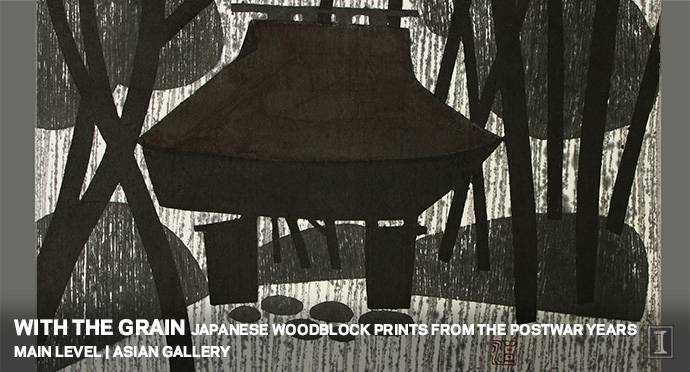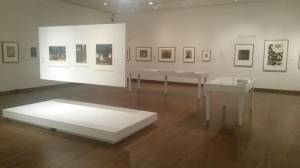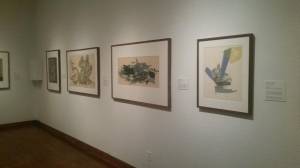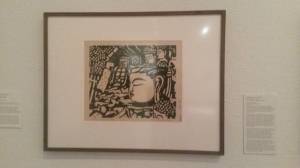
As ashamed as I am to admit it, I am unfortunately one of those people who very rarely make it to museums or exhibits, even if I know it’s going to make me into a more knowledgeable person. I always struggle to find the time or the will, so I was very excited when I was assigned to check out the With the Grain: Japanese Woodblock Prints from the Postwar Years exhibit.
Held at Krannert Art Museum, the focus of the exhibit is on sosaku hanga, or “creative prints”. Sosaku hanga artists began in 1918, and their style reflected a marked change from previous wood-blocking techniques that emphasized old-fashioned techniques and also publication from commercial houses. Knowing that the exhibit showcases pieces from the late 1950’s and 1960’s, I walked in excited to experience a very different type of art, but I was also a little nervous about whether or not With the Grain would grab my attention or let me just meander along without really absorbing anything.
 All in all, I ended up quite enjoying what I saw, in terms of both the art on the display and its presentation. The set-up is minimal and simple, with different wood-block pieces evenly lined across all four walls, plus two tables with prints and a hanging piece in the center of the room. This setup allows you to start at the beginning as soon as you walk in the room then progress at your own pace — which, if you’re like me, helps to minimize the impulse to go check out the weird modern art piece sitting in the next room.
All in all, I ended up quite enjoying what I saw, in terms of both the art on the display and its presentation. The set-up is minimal and simple, with different wood-block pieces evenly lined across all four walls, plus two tables with prints and a hanging piece in the center of the room. This setup allows you to start at the beginning as soon as you walk in the room then progress at your own pace — which, if you’re like me, helps to minimize the impulse to go check out the weird modern art piece sitting in the next room.
The first section, In the Aftermath of War, showcases four prints that focus on the destruction caused by World War II. At first they appear deceptively simple, and it took me a few moments looking at the prints to grasp the feelings the artists wanted to convey. For a few of the prints, my initial impression was a mild confusion as I tried to understand the more abstract pieces, but it struck me that that was probably what the artists wanted their viewers to feel. Confusion and a desire to understand are feelings I assume many people after WWII were experiencing.
From there the exhibit moves on to Humble Customs and Festivals, a much more lighthearted portion of the exhibit that is a welcome break from the darker beginning prints. All color woodcuts, the prints were made by artists who fled to the countryside during the war, and “desired to become reacquainted with rural occupations and native arts and skills.” The prints feature subjects such as a flower vendor and festivals, and they are lovely. The techniques used in the design and production might look simple, but upon reading the descriptions offered with each piece, it is clear that making successful wood-blocks is time-consuming and difficult. Each piece offers an opportunity to understand the loss people experienced through their attempts to avoid modern society and connect with a more natural way of living.
 In keeping with the exhibit’s chronological progression, next comes The Past Remembered, which features a unique style of wood-blocking in which the artists deliberately rebelled against the traditional methods of wood-block printing. They wanted a more independent style, and typically depicted older figures or characters, such as the Buddha. While the prints use ancient characters, they do not feel old or dull; rather, they present a natural change in artistic style that speaks not only to the changes Japan was going through at the time, but also to a signal for the continual modernization of Japanese wood-blocking.
In keeping with the exhibit’s chronological progression, next comes The Past Remembered, which features a unique style of wood-blocking in which the artists deliberately rebelled against the traditional methods of wood-block printing. They wanted a more independent style, and typically depicted older figures or characters, such as the Buddha. While the prints use ancient characters, they do not feel old or dull; rather, they present a natural change in artistic style that speaks not only to the changes Japan was going through at the time, but also to a signal for the continual modernization of Japanese wood-blocking.
The final section, Reinventing a “Very Japanese Art”, showcases prints that are a complete break with the traditional form. Modern hanga artists now “turn to western-style painting and wood-engravings,” and this major shift is reflected in the pieces. Much more unusual and abstract than the other prints, particularly those found in Humble Customs and Festivals, this section in the exhibit is the only portion I didn’t seriously connect with. With In the Aftermath of War, a print’s abstractness helped add to its meaning; these last prints, however, only left me confused and without anything to fall back on.
 I had never been to anything like the Japanese Wood-blocking exhibit, and I left the museum very pleased I’d gone. I was able to learn about a style of art I knew practically nothing about and also get a glimpse into what Japan was experiencing after World War II through the perception of its artists. This exhibit would not be something I’d recommend as a casual family outing, for instance; but, for any teenager or adult looking for a unique art and culture experience, I’d certainly suggest the Japanese Wood-blocking exhibit.
I had never been to anything like the Japanese Wood-blocking exhibit, and I left the museum very pleased I’d gone. I was able to learn about a style of art I knew practically nothing about and also get a glimpse into what Japan was experiencing after World War II through the perception of its artists. This exhibit would not be something I’d recommend as a casual family outing, for instance; but, for any teenager or adult looking for a unique art and culture experience, I’d certainly suggest the Japanese Wood-blocking exhibit.
This exhibit is open through May 17th at the Krannert Art Museum, located at 500 E. Peabody Drive, C. KAM is open 9am to 5 pm Monday through Saturday, with late hours 5-9pm on Thursdays. The museum is closed on Sunday. There is no entrance fee, but a $3 donation is suggested.
Photo credit (last image, above): Hiratsuka Un’ichi. Stone Images of Buddha of Usuki, 20th century. Woodblock print. University of Illinois Purchase 1957-19-6. Courtesy of Krannert Art Museum.
All other photos by Meghan McCoy, for Smile Politely.








